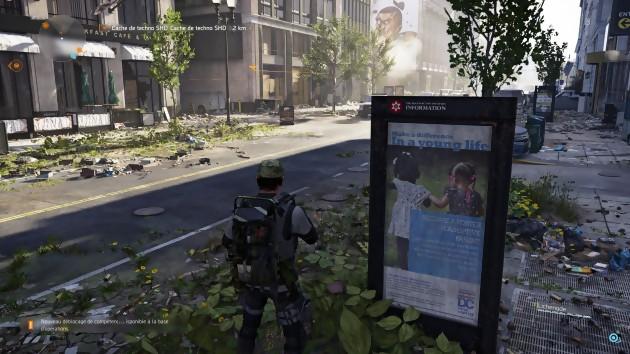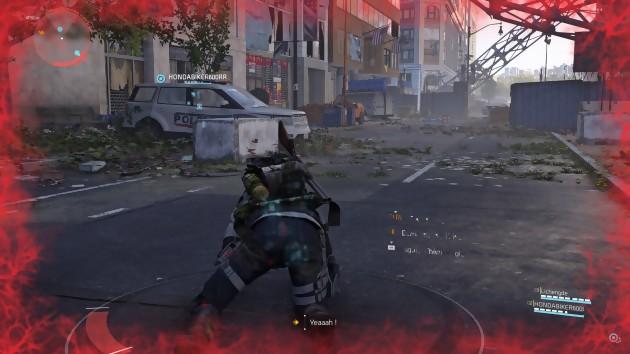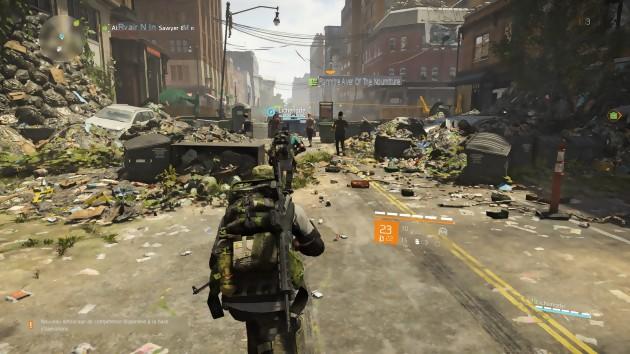 Seven months have passed since the events of The Division. The hardcore smallpox that had spread in New York via banknotes is now affecting the American capital. If Washington DC in the spring is not as iconic as the Big Apple under the snow for us Europeans, the work done on the environments remains very impressive. The post-disaster atmosphere is perfectly transcribed through the abandoned buildings, the broken windows and the thousands of debris strewn on the ground. Nature even begins to take back its rights, since you can see some stray animals in the streets, and a lot of vegetation in the middle of the concrete. In short, the art direction is excellent, the interior and exterior environments are extremely detailed, and the graphics engine is powerful enough to display all of this in a convincing and fluid way. However, during cutscenes, the faces of most characters suffer from imperfect animations. Add to that a basic paramilitary scenario, as well as a totally silent hero who comes to shoot down the immersion as soon as an interlocutor speaks to him, and you will quickly understand that The Division 2 should absolutely not be approached as a solo adventure. . It is a pure looter shooter, and it is therefore the gameplay and the comfort of play that have most caught the attention of the developers. Thus, the world is traversed without loading time (hello Anthem…), it is very easy to find partners on the go and, in general, no major bug or significant technical problem comes to taint the gaming experience. From its launch, The Division 2 comes out in a very good state of finish, which is far from being the case for all "games as a service". We feel that the experience, acquired on the first episode and the beneficial updates to which it has been entitled in recent years, has been used to offer players a very solid title from the outset.
Seven months have passed since the events of The Division. The hardcore smallpox that had spread in New York via banknotes is now affecting the American capital. If Washington DC in the spring is not as iconic as the Big Apple under the snow for us Europeans, the work done on the environments remains very impressive. The post-disaster atmosphere is perfectly transcribed through the abandoned buildings, the broken windows and the thousands of debris strewn on the ground. Nature even begins to take back its rights, since you can see some stray animals in the streets, and a lot of vegetation in the middle of the concrete. In short, the art direction is excellent, the interior and exterior environments are extremely detailed, and the graphics engine is powerful enough to display all of this in a convincing and fluid way. However, during cutscenes, the faces of most characters suffer from imperfect animations. Add to that a basic paramilitary scenario, as well as a totally silent hero who comes to shoot down the immersion as soon as an interlocutor speaks to him, and you will quickly understand that The Division 2 should absolutely not be approached as a solo adventure. . It is a pure looter shooter, and it is therefore the gameplay and the comfort of play that have most caught the attention of the developers. Thus, the world is traversed without loading time (hello Anthem…), it is very easy to find partners on the go and, in general, no major bug or significant technical problem comes to taint the gaming experience. From its launch, The Division 2 comes out in a very good state of finish, which is far from being the case for all "games as a service". We feel that the experience, acquired on the first episode and the beneficial updates to which it has been entitled in recent years, has been used to offer players a very solid title from the outset.
UNKNOWN LAND OR KNOWN LAND?
 In return, it must be recognized that the game does not innovate much compared to the previous part. The watchword of the developers was clearly to refine the experience as much as possible rather than to revolutionize it. Under these conditions, it is impossible to escape "The Division 1.5" syndrome, even if real efforts have been made to diversify activities as much as possible (within the limits of what the codified genre and the realistic universe allow). In parallel with the gameplay based on cover elements and the many gadgets to unlock (drones, turrets, remote-controlled mines, etc.), there is a jumble of main missions, side missions, control points to capture, enemy patrols to confront, allied patrols to accompany, hostages to free, propaganda broadcast to deactivate, echoes of the past to discover, resources to collect, weapons to dismantle, items to craft, hideouts to liberate, and a main base of operations to improve. Incidentally, the latter is none other than the White House itself! There is therefore plenty to do even if, over the hours, a certain repetitiveness inevitably emerges. Especially since we find the problem of "PV bags" which had disturbed some players of the first episode. That it takes several bullets to kill an enemy, nothing more normal in a game that brandishes the carrot of the loot. If all guns could kill in one shot, the arms race would no longer exist. But in a realistic universe, seeing a human receiving several headshots without flinching poses a problem of dissonance. To remedy this, The Division 2 offers us bosses and mini-bosses with armor that can be knocked down piece by piece. By always aiming at the same place, you can reach a vulnerable area more easily and quickly. It's a good thing, but with an obsolete weapon you will always have to empty many magazines to take down the slightest basic enemy...
In return, it must be recognized that the game does not innovate much compared to the previous part. The watchword of the developers was clearly to refine the experience as much as possible rather than to revolutionize it. Under these conditions, it is impossible to escape "The Division 1.5" syndrome, even if real efforts have been made to diversify activities as much as possible (within the limits of what the codified genre and the realistic universe allow). In parallel with the gameplay based on cover elements and the many gadgets to unlock (drones, turrets, remote-controlled mines, etc.), there is a jumble of main missions, side missions, control points to capture, enemy patrols to confront, allied patrols to accompany, hostages to free, propaganda broadcast to deactivate, echoes of the past to discover, resources to collect, weapons to dismantle, items to craft, hideouts to liberate, and a main base of operations to improve. Incidentally, the latter is none other than the White House itself! There is therefore plenty to do even if, over the hours, a certain repetitiveness inevitably emerges. Especially since we find the problem of "PV bags" which had disturbed some players of the first episode. That it takes several bullets to kill an enemy, nothing more normal in a game that brandishes the carrot of the loot. If all guns could kill in one shot, the arms race would no longer exist. But in a realistic universe, seeing a human receiving several headshots without flinching poses a problem of dissonance. To remedy this, The Division 2 offers us bosses and mini-bosses with armor that can be knocked down piece by piece. By always aiming at the same place, you can reach a vulnerable area more easily and quickly. It's a good thing, but with an obsolete weapon you will always have to empty many magazines to take down the slightest basic enemy...
With six Ubisoft studios at work, The Division 2 is a big, well-oiled machine, which benefits from the experience acquired on the first part.
 Fortunately, the loot table is very well made. Weapons and other pieces of gear are spread across seven different quality tiers, and the drop rate is high enough to keep players motivated all the time. The Division 2 seems to have found the right balance between excessive "loot shower" and too much and therefore frustrating scarcity. You always want to play ten more minutes hoping to come across a legendary weapon, and when you do, you want to try it immediately, and therefore keep playing. In short, the typical addiction of looter shooters and Diablo-like answers the call. Ubisoft's title also shines with an overall very convincing artificial intelligence. Indeed, the enemies reposition themselves regularly and often seek to take us from behind. This does not prevent from time to time to attend much more questionable behavior, as when the soldiers climb one after the other on a ladder to be systematically picked up on arrival. But in general, the AI gives the change and forces the players to remain permanently on their guard and to change shelter often. The clashes are therefore dynamic as desired, and avoid the too static aspect that harms many TPS based on a cover mechanic. And that's good, because it takes long hours to complete the campaign. Count between thirty and forty hours to visit the entire map, complete most missions and reach the maximum level set at 30. And even at this point, you will not be finished with The Division 2, which offers rich endgame content as soon as it is released. After the skinny Anthem (which shines all the same by its gameplay, let's never forget it), it feels damn good!
Fortunately, the loot table is very well made. Weapons and other pieces of gear are spread across seven different quality tiers, and the drop rate is high enough to keep players motivated all the time. The Division 2 seems to have found the right balance between excessive "loot shower" and too much and therefore frustrating scarcity. You always want to play ten more minutes hoping to come across a legendary weapon, and when you do, you want to try it immediately, and therefore keep playing. In short, the typical addiction of looter shooters and Diablo-like answers the call. Ubisoft's title also shines with an overall very convincing artificial intelligence. Indeed, the enemies reposition themselves regularly and often seek to take us from behind. This does not prevent from time to time to attend much more questionable behavior, as when the soldiers climb one after the other on a ladder to be systematically picked up on arrival. But in general, the AI gives the change and forces the players to remain permanently on their guard and to change shelter often. The clashes are therefore dynamic as desired, and avoid the too static aspect that harms many TPS based on a cover mechanic. And that's good, because it takes long hours to complete the campaign. Count between thirty and forty hours to visit the entire map, complete most missions and reach the maximum level set at 30. And even at this point, you will not be finished with The Division 2, which offers rich endgame content as soon as it is released. After the skinny Anthem (which shines all the same by its gameplay, let's never forget it), it feels damn good!
WE TAKE THE SAME AND START AGAIN ?
 Thus, you can continue the fights by adopting a specialization to choose from three. Sniper, Demolisher and Survivalist each have a particular talent tree, as well as a signature weapon (sniper rifle, grenade launcher or crossbow). Moreover, the feeling of progress in the game is maintained by the presence of fortresses to storm, while the invasion of the map by a new faction renews the desire to fight. Black Tusk soldiers are equipped with the latest technology, and they don't hesitate to occupy checkpoints or hideouts that you thought you had made yours forever. The game also offers a system of priority targets in order to always give the player more grain to grind. But that's not all ! You can also count on a standardized PvP mode, called Conflict, which allows you to face other players in different classic modes (Deathmatch and Domination for the moment). Naturally, The Division's Dark Zone also makes a return. We even have the right to three different areas this time, each of them offering a particular playground. As for those left unmoved by PvP, they can count on the three free downloadable contents planned for the coming year. The first will take us around the suburbs of Washington DC, while the second will take us squarely to the Pentagon (no information has yet filtered regarding the third DLC). More generous than usual, Ubisoft has still not forgotten to offer micro-transactions and to impose a permanent compulsory connection, of course. In the end, The Division 2 appears to be a very well-crafted production, which only really fails in its realistic universe, which prevents any real fantasy, its lack of innovation compared to the previous part, and a certain lack of soul that you can't help noticing. The ultimate blockbuster!
Thus, you can continue the fights by adopting a specialization to choose from three. Sniper, Demolisher and Survivalist each have a particular talent tree, as well as a signature weapon (sniper rifle, grenade launcher or crossbow). Moreover, the feeling of progress in the game is maintained by the presence of fortresses to storm, while the invasion of the map by a new faction renews the desire to fight. Black Tusk soldiers are equipped with the latest technology, and they don't hesitate to occupy checkpoints or hideouts that you thought you had made yours forever. The game also offers a system of priority targets in order to always give the player more grain to grind. But that's not all ! You can also count on a standardized PvP mode, called Conflict, which allows you to face other players in different classic modes (Deathmatch and Domination for the moment). Naturally, The Division's Dark Zone also makes a return. We even have the right to three different areas this time, each of them offering a particular playground. As for those left unmoved by PvP, they can count on the three free downloadable contents planned for the coming year. The first will take us around the suburbs of Washington DC, while the second will take us squarely to the Pentagon (no information has yet filtered regarding the third DLC). More generous than usual, Ubisoft has still not forgotten to offer micro-transactions and to impose a permanent compulsory connection, of course. In the end, The Division 2 appears to be a very well-crafted production, which only really fails in its realistic universe, which prevents any real fantasy, its lack of innovation compared to the previous part, and a certain lack of soul that you can't help noticing. The ultimate blockbuster!


























